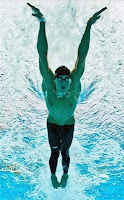Enough history, let's talk swimming.
Why is leaping important in swimming? It plays a major role in two things. Starts would be the obvious scenario in which a swimmer performs a "leaping" motion, but the same motion can directly be applied to turns/push-offs.
Diving:
Diving off the starting blocks definitely requires a leap. Generally, the further you jump off of the blocks, the better your start will be. However, this is only true to a certain extent. Check out the scenarios below:
The drawing is very rough but you get the point. The black thing is a starting block, the blue is the water, the brown spider-looking thing is the swimmer. In this first scenario, the swimmer (let's call them Regan) falls into the water. She dives head first but her angle of entry into the water takes her straight down to the bottom. Once Regan realizes that she is too deep, she has the task of swimming all the way back to the surface before she can really begin her race. All of this is the result of Regan not leaping.
In the second scenario, the swimmer (let's call them Maddie) leaps really far. This gets Maddie out away from the wall and keeps her from going too deep, but the entry into the water is so shallow that it is almost a belly-flop. The first reason you don't want to do this is because a belly-flop will hurt! Then second reason is that your body hits at such a flat angle that your legs enter at a different spot than your head. This may not seem like to big of a deal but it is kind of like putting on the brakes when you hit the water and in a race you can't afford that.

The final scenario has the swimmer (let's call them Mitchell) leaps up and out off the block. Notice that the first movement isn't down and out, but a slightly upward movement along with the outward. Mitchell jumps far off of the block, but not too far like Maddie. This allows him to get out a ways before entering the water, but his entire body can still enter the water through the same small space allowing maximum speed forward and minimal time spent "putting on the brakes". Mitchell doesn't go too deep in the water, but it is deep enough that he can use his underwater kicking to get him quickly to the surface.
I threw out a term in there that I want to explain. When I talk about "entering the water through the same hole" it means that the entire body (fingertips, arms, head, shoulders, torso, hips, legs, and feet) is entering the water as if it was going through a hula hoop. This creates less splash and maximum forward velocity.
Push-offs:
When you push off the wall after a turn, it is the same exact motion as jumping straight up into the air from the ground. The harder you can push off (or in this case "leap") the further you will get on your push off and your performances will get substantially better. Working on your push-off power outside of the water is simple. You can do any number of jumping exercises. Box jumps are a very good replication of the movement required to push off of the wall. Performing any of the jumping exercises while in a streamline position definitely increases the likeness of the push-off movement.
Since starts and push-offs are all about power and explosiveness, it helps to build up strength in the quadriceps, hamstrings, and calves. The explosiveness can be achieved by performing exercises at maximum effort. Jumping as high as possible on every jump and trying to use every single muscle in your legs will help to work on that explosiveness,
Leaping is very important in two primary aspects of swimming. Starts and turns are easy places to save time in races without having to put in thousands and thousands of yards. When it comes down to it, the more explosive you are off of the blocks and walls the better your starts and turns will be.
On a side note: swimming is very important to many people in the Boone community and is equally important to millions of people around the world. Swimming is a lifelong sport and provides a sense of camaraderie that you will not find in any other sport. Currently, the Boone school district is trying to come up with ways to save money on their new renovation project and one of their options is shutting down the pool for good. This would more than likely eliminate the swimming program at Boone High School and would leave many kids wondering what they could have done. We never want to leave kids wondering what could have been. As coaches, parents, swimmers, and friends are job is to give athletes a chance to evolve their talents and grow in the sport. Hopefully this decision by the school board does not leave Boone without a swimming program.


